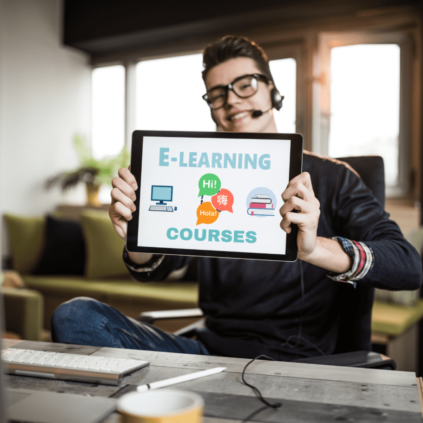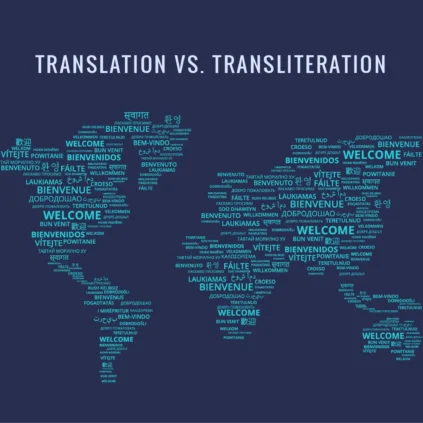About E-Learning Translation:
eLearning translation refers to translating educational content and training materials from one language to another. It involves translating and localizing course materials, presentations, videos, assessments, and other resources into a target language to make them accessible and understandable to learners of different languages.
eLearning has become a useful tool for online training and education across the education industry. The need for translation in eLearning has increased significantly due to the growing educational content trends that can be accessed through software and mobile apps. By translating eLearning content into multiple languages, companies can now overcome the language barriers between languages and reap many advantages.
In this article, we’ll examine the benefits that come with eLearning Translation and discuss how this could revolutionize the way we learn
Expanded Reach and Global Accessibility:
One of the benefits of eLearning translation is the ability to increase the reach of educational content to a global audience. By translating eLearning materials into different languages, companies can make their courses accessible to learners from various linguistic backgrounds. This increases the reach of their educational initiatives and promotes diversity in the learning environment. Learners who may have been excluded due to language barriers can now engage with the content in their native language, enhancing their overall learning experience.
Enhanced Learning Engagement:
When learners can access eLearning content in their native language, it significantly improves their engagement and their knowledge. Language plays a crucial role in understanding complex concepts. When learners are comfortable with their native language used in the course, they can focus on grasping the subject matter instead of struggling with unfamiliar vocabulary or sentence structures. Translated eLearning content ensures that learners can fully comprehend the material, leading to better retention and application of knowledge.
Cultural Adaptation and Contextualization:
Translation of eLearning content requires more than just translating phrases from one to another; it also requires adapting the content to diverse cultural contexts. Every culture has distinct nuances and methods of communicating, and eLearning translation takes these aspects into consideration. Through the incorporation of cultural adaptations and contextualization, companies can ensure that their online courses are able to hit students from different backgrounds. This creates an inclusive learning environment that makes students more engaged with their content and helps them gain a better comprehension of the subject.
Compliance with Local Regulations and Standards:
Compliance with local regulations and standards is of utmost importance in certain industries. Translating eLearning content ensures that organizations can meet these requirements effectively. By offering classes that are in the language of your local area, companies can ensure that students are able to access the required instructional materials needed to meet specific rules and regulations. This is crucial for healthcare, finance, and legal fields in which precise and exact knowledge is vital to professional development and compliance.
Cost-Effective and Scalable Solution:
eLearning translation offers a cost-effective and scalable solution for organizations looking to expand their training programs globally. Compared to traditional classroom-based training, eLearning allows for easy and efficient distribution of translated content to learners across different locations. Once the initial translation work is complete, the translated eLearning materials can be reused and updated as needed, reducing the cost of creating new courses. This scalability enables organizations to rapidly deploy training programs to cater to their growing global workforce or customer base.
Here are some key points about eLearning translation:
1. Localization: eLearning translation goes beyond word-for-word translation. It involves localization, which means adapting the content to suit the target culture, language, and educational context. eLearning translation may include adjusting examples, cultural references, images, and instructional strategies to ensure maximum comprehension and engagement.
2. Textual Translation: Written content such as instructional text, course materials, quizzes, and assessments need to be translated accurately. Professional translators who have expertise in the field and knowledge of both the target and source languages are typically employed to perform this job.
3. Multimedia Translation: eLearning often includes multimedia elements like videos, audio recordings, and interactive simulations. These multimedia components may require subtitling, voice-over recording, or complete re-creation in the target language to maintain instructional value and effectiveness.
4. Technical Considerations: eLearning platforms and learning management systems (LMS) may have technical limitations or specific requirements for translation implementation. Translators and eLearning developers must collaborate to ensure the translated content fits seamlessly into the platform without technical issues.
5. Quality Assurance: As with any translation project, quality assurance is crucial in eLearning translation. Thorough proofreading, editing, and testing are necessary to ensure the translated content’s accuracy, consistency, and functionality.
6. Accessibility: Translated eLearning content should be accessible to learners with different abilities. Translation includes providing options for captions, transcripts, and alternative formats and ensuring compatibility with assistive technologies.
7. Continuous Improvement: eLearning translation is an iterative process. Feedback from learners, instructors, and stakeholders should be considered to refine and improve the translated content over time.
It’s important to work with professional translation services or eLearning localization specialists who have experience in eLearning content and understand the unique challenges and requirements of translating educational materials for online learning.
Translation of eLearning courses into Multiple Languages
Reference and training materials can be translated into various languages to help more learners increase their reach and improve efficiency through online courses.
Dialect LLC works with various mediums and file formats to locate your eLearning material precisely. Our expertise in translating and localizing online courses includes the following:
- Online help
- User Interfaces
- XML content files
- Course documentation
- Multimedia elements (video/audio), including video subtitles & multilingual voice over
- Web-based training
- CBT (Computer Based Training)
- CBI (Computer Based Instruction)
- Graphics and Desktop Publishing
Conclusion:
eLearning translation presents numerous benefits, from expanded global reach and improved engagement to cultural adaptation and compliance. By investing in eLearning translation services, organizations can tap into new markets, promote inclusivity, and enhance learning outcomes for diverse learners.





